We’ve been living in an RV for 20 years now, and we do a lot of boondocking. So, we’ve had to master the art of keeping the rig level. Which is more important than you may think! It’s so important, in fact, that we’re dedicating this post to what we think are the best RV leveling blocks you can buy (for any class of RV).
As you might imagine, over 20 years, we’ve tried our share of leveling blocks. In time, however, most types of RV leveling blocks failed us in one way or another. So, in this post, we’ll tell you AND show you why we believe Utility Blocks are the best your money can buy.
Why Are RV Leveling Blocks Important?
An off-level RV is a bigger problem than many people think it is. Not only is it a nuisance for walking, sleeping, and having things slide off your table… but, it can be hazardous to your appliances and even to parts of your RV.
Every RVer has to deal with unlevel campsites from time to time. Even if your RV has a great leveling system (not just stabilizer jacks), some sites are so sloped you just can’t get your rig level.
This is why most RVers carry RV leveling blocks of some kind or other.
Sometimes called “jack pads”, “stacker blocks”, or “stabilizer pads”, RV leveling blocks not only allow you to level your RV on a sloped campsite, but they can also help keep jacks from sinking into soft surfaces.
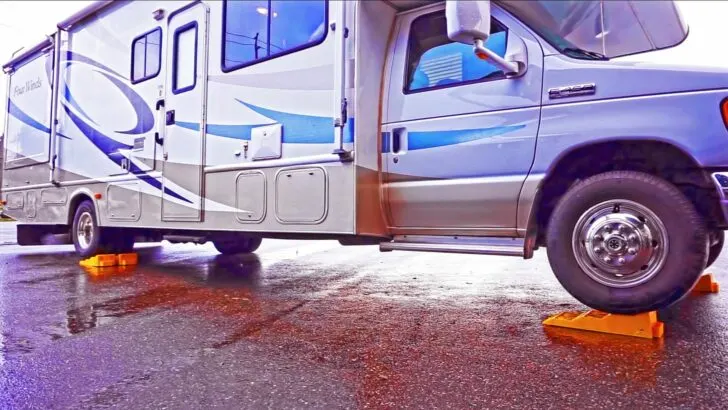
RV leveling blocks or pads are an important piece of RVing gear. Keeping the rig level and above the surface is more important than you may realize.
Even if you think you don’t need them, RV leveling blocks should be on every RVer’s list of “most important gear” for a number of reasons.
First, if you can’t get your rig level, your fridge may not work properly or could even be damaged. RV fridge problems can lead to a fire which could cause a total loss of your rig… or worse.
Other appliances could also suffer, or fail to function properly, as a result of a non-level RV as well.
Finally, as we noted in our post answering the question “Do you need leveling blocks?“, you may need them because sometimes your built-in levelers just aren’t enough to make your RV level.
This is generally the case when you’re on extremely sloped sites, or sites with soft ground into which your jacks will sink.
So, the ability to level your RV is pretty crucial. The problem is that there are many RV leveling systems out there (electric, hydraulic, or air), and, while many are great, no one system covers all the bases.
No matter how great your RV’s leveling jacks may be, no RV leveling system is complete without a good, durable set of RV leveling blocks (and some wheel chocks).
Are All RV Leveling Blocks the Same?
No. RV leveling blocks aren’t all the same at all. They vary widely, and most really haven’t been sufficient for use with our motorhome.
The most commonly used leveling blocks are wood (often homemade) or the commonly-available plastic stacker blocks.
Wood Blocks
Wooden blocks can be helpful (and cheap!), but, over time, they can crack, chip, or rot. They also tend to be quite heavy, especially for full-timers like us who are conscious of how much weight we carry.
Blocks of wood also don’t have any sort of leveling ramps to them for a gradual roll-up (unless you have to tools & skill to make them yourself).
Many people carry wooden blocks, but there are far lighter, more compact, and more effective camper levelers out there.
Typical Plastic Stacker Blocks
Plastic stacker blocks (the ones commonly found at RV parts stores) are readily available, usually reasonably priced, lightweight, and compact for easy storage. But their downside is that they have a waffle-like grid bottom (which makes them lighter and cheaper) that allows them to sink into soft surfaces.
Also, they’re not always strong enough to support a heavier RV without cracking, especially on soft or uneven surfaces that allow them to flex.
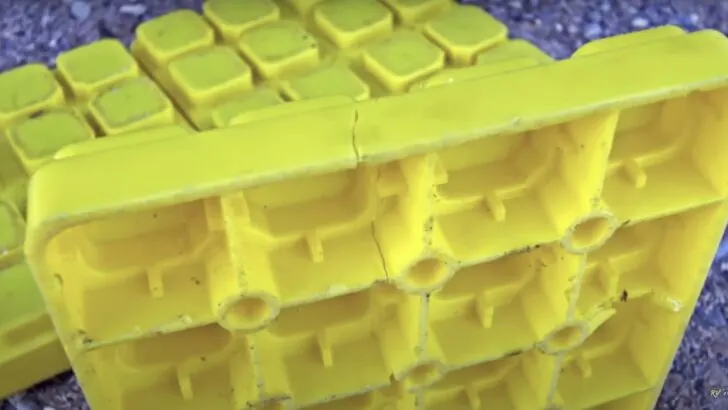
These are our old plastic stackers that cracked under use.
There are lots of reviews of products like the Camco 44510 heavy-duty leveling blocks, Lynx levelers, and a number of other popular leveling blocks stating that they slide, crack, or simply don’t last very long.
Even though products like the Camco heavy-duty leveling blocks are supposed to have a decent weight capacity, there are plenty of complaints of them bending under load and sinking into the soil or gravel.
Our Choice for the Best RV Leveling Blocks
With all of that said about the two most common choices in leveler kits, our choice after 20 years of full-time RVing are Utility Blocks.
We’ve found Utility Blocks to be perfect for about 98% of the places where we camp (and we camp in some pretty “out there” places!). In our opinion, they’re the perfect balance of size, weight, strength, and cost.
They’re big enough to provide a good surface area to help prevent your jacks from sinking into soft/wet ground while still being thick enough to provide good lift. Surprisingly, they do both of these without being too large or heavy (their approximate size is 9 1/2″ x 9 1/2″ x 1 1/2″).
Even though they weigh only about 3.5 pounds each, they seem indestructible, and the price for what you get is very reasonable compared to anything else we’ve found.
Sure, they’re more expensive than cheaper plastic blocks… but they still cost a lot less than many other “high-end” jack pads without sacrificing quality.
Other features that we’ve found to be beneficial include the 45-degree angle bevels on each side that act as ramps when you drive/pull your RV up onto them.
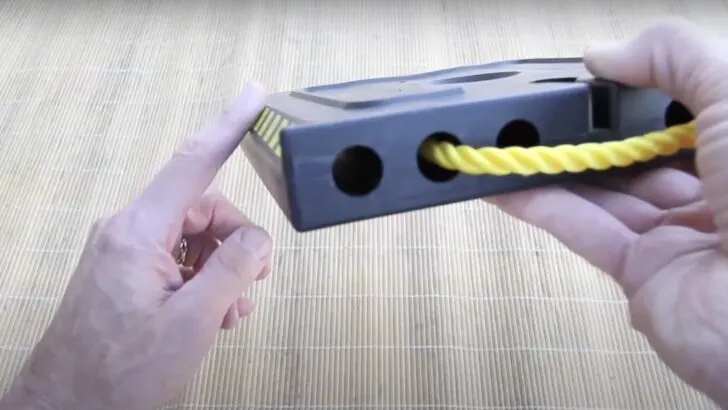
45-degree angle bevels on each side of a Utility Block make it easy to drive a rig up the block(s).
They also have a rope handle that makes it easy to pull them out from under your RV when you’re ready to pack up camp. If you don’t want to bend over to reach them, use your RV’s awning rod… it’s easy to use the rod to grab the rope handles and pull them out from under your (retracted) jacks, without having to bend down.
While we’re talking about using your awning rod, it can also be used to put the Utility Blocks in place. There’s a keyed notch that your RV awning rod can fit into, making it easier to move them into place, again without having to get down on your hands and knees!
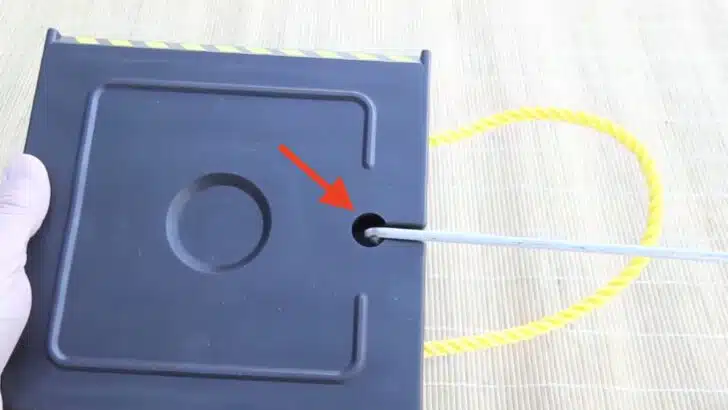
Utility Blocks have a keyed notch to accommodate an awning rod so you can put them in place without getting down on the ground.
Utility Blocks are almost entirely flat on the bottom. There’s only one groove that allows the block to lock into another one when stacking them. When you park your RV on the blocks, the raised ridge on the top and the recessed groove on the bottom nest together perfectly, so there’s no sliding or slippage.
As sturdy as they are, Utility Blocks save weight without compromising integrity or strength. They do this by having holes bored all the way through, lengthwise. However, with their solid top and bottom, there are no open areas to sink onto wet or soft ground.
They’re also larger than many of the cheaper blocks, so they’re less likely to sink into soft surfaces, and they’re taller than most other RV leveling blocks, offering more lift when using the leveling blocks to level your RV on badly-sloped surfaces.
If you have a travel trailer, Utility Blocks also have a circular recess in the top, designed to be used with the tongue jack. This helps hold the wheel or jack foot in place while you’re parked, helping to keep things more stable.
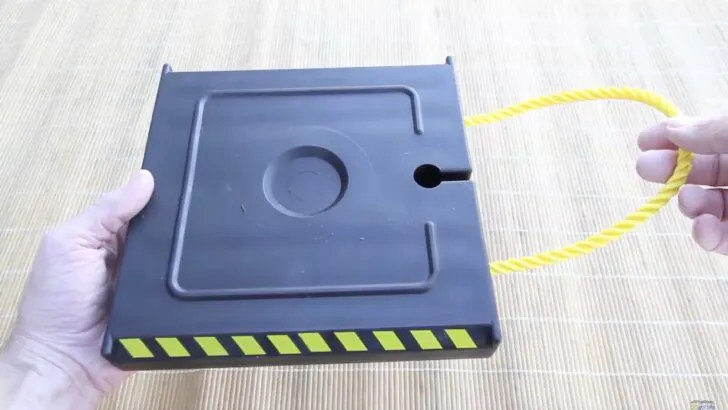
Utility Blocks have a circular recess in the top to support a travel trailer’s tongue jack, and a bright yellow cord for retrieving the block (which is more helpful than you may think).
So, these are all of the reasons that we think that Utility Blocks are the best RV leveling blocks around. But we do have a couple of notes:
- We have a 43′ diesel pusher, so it’s a fairly heavy rig. Utility Blocks work fine for us, but if you have a larger, heavier motorhome, you may need jack pads with a larger surface area than Utility Blocks provide.
- While they’re less expensive than other premium jack pads, they’re still more expensive than basic plastic leveling pads.
You can purchase one Utility Block or a set of four.
For a visual look at Utility Blocks and our take on why they work even better than more expensive RV leveling blocks, feel free to check out our YouTube video, made about 10 years after we purchased our first set:
And now that you’re all set with your leveling blocks, learn how to use them to level your travel trailer or level your motorhome.
Free RVing Tips, Tricks, Reviews, Giveaways & More
Subscribe to our daily newsletter! We’ve been full-time RVers for 20 years (!) and share everything we’ve learned about RVing in our daily blog posts. Join our online community to receive a wealth of great RVing knowledge delivered right to your inbox.
Whether this is your first time on the road or you’re a seasoned full-timer, you’ll love the wide range of RVing topics we cover. Don’t miss a single article or any of our famous RV gear Giveaways — Subscribe today!




Jennifer Sadugor
Sunday 3rd of March 2024
The review state that if you use more than two at a time, they slip. Have you had that experience? Is it possible to do a video of you using them. The one on Amazon is not very good. Also, what would be your next choice? I have Anderson leveling blocks but they were not high enough for where I am right now. Thank you.
TheRVgeeks
Sunday 3rd of March 2024
Hi Jennifer! The top of each Utility Block has a ridge that mates perfectly with the channel on the bottom of each block, which prevents them from slipping against each other. The only thing they don't do is lock together when placed side by side. Stacking them two high usually works really well for driving right up onto the two of them. But if you go higher than two, you'd likely want to place a single block in front of the stack to act as a ramp. This is the most common place you could run into slipping... but not slipping off each other as much as the bottom block slipping on smooth ground. The most common time we've found this to be a problem is being very off-level on a hard surface, like asphalt for example. Luckily, harder/smoother campsites (asphalt/concrete) are also the most likely to be more level. Less infrastructure (dirt or gravel, or even grass... if it's not wet) is where the most leveling is usually needed, and luckily those provide a bit more traction to hold the bottom block in place. That said, going more than about two high can be more challenging with many stackers. We have friends with Anderson levelers like yours, so we're familiar with them. If you're maxing out their height and still not getting level, your site is indeed pretty off-level. We do have a line on a new type of stacker pad that's coming out soon, and we're working on trying to get a set for our new RV, which we're taking delivery of this spring. From what we've seen so far, it may be at least a bit of a game-changer. We'll report back as we take delivery of our new rig and start sharing details. Unfortunately, we sold our motorhome, so we're not able to film anything right now. But since our new rig will be a towable, all the gear we use on it will be chosen for how well it works for towables specifically. Since driving onto pads differs from using them under hydraulic jacks, our upcoming use of them should be even more on-target for other towable owners. Stay tuned!
bm
Monday 22nd of May 2023
Ordered a set of 4 from Amazon, but it was cancelled after a day.
TheRVgeeks
Monday 22nd of May 2023
Sorry to hear that, but keep in mind that Amazon isn't always the shipper... sometimes it's through Amazon Marketplace, which means a third-party supplier can be involved. Trust us... they're worth trying to order them again.
TN
Sunday 14th of May 2023
Hi Guys, Thanks for another great review. I have been wanting to change out my plastic waffle blocks for awhile. I do not enjoy digging them out of the ground and cleaning them when we are packing up to leave. Over your years of travel and all the locations you have been, How many blocks do you guys now carry to fit your needs. Thank you
TheRVgeeks
Tuesday 16th of May 2023
Hi TN. We had one set of four Utility Blocks for a long time... but somewhere along the line (probably when we started doing more boondocking and spending more time in less developed places) we picked up a second set of four and now travel with eight of them. It's not often that we need the extra 4... but, on occasion, they've come in handy.
Rich
Sunday 14th of May 2023
I have also have had these blocks for many years, but now that I have a larger RV (2017 Newmar Ventana) I find the stands on this unit actually overlap these pads more than I would like, so I am on the lookout for even larger ones.
That being said, these are very good pads and are pretty indestructible.
michael
Sunday 14th of May 2023
@Rich, Before I discovered these (I have 8 and can't remember how long ago I got them), I went to a plastics shop and bought a 1" sheet of polypropylene (I'm pretty sure that's the material). I had them cut to a foot square and drilled holes on diagonal corners.
I still have them and the utility squares. Depending on what I need, I still use both. I am in a 42,000 lb. 45-foot motor home and they work great.